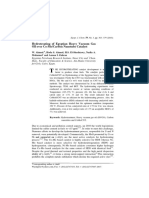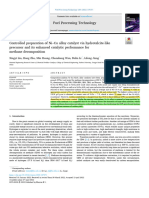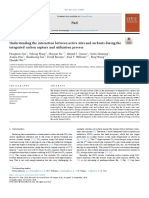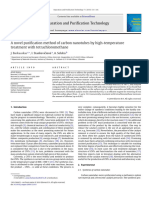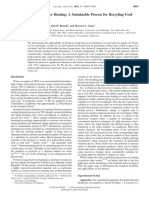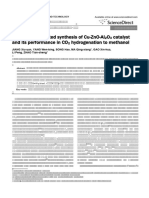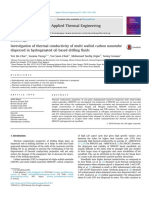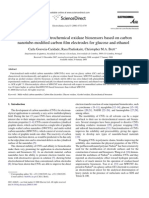Synthesis of Single-Walled Carbon
Synthesis of Single-Walled Carbon
Uploaded by
Mariel MinozCopyright:
Available Formats
Synthesis of Single-Walled Carbon
Synthesis of Single-Walled Carbon
Uploaded by
Mariel MinozOriginal Description:
Original Title
Copyright
Available Formats
Share this document
Did you find this document useful?
Is this content inappropriate?
Copyright:
Available Formats
Synthesis of Single-Walled Carbon
Synthesis of Single-Walled Carbon
Uploaded by
Mariel MinozCopyright:
Available Formats
NANO: Brief Reports and Reviews Vol. 3, No.
2 (2008) 95100 c World Scientic Publishing Company
SYNTHESIS OF SINGLE-WALLED CARBON NANOTUBES FROM LIQUEFIED PETROLEUM GAS
QIANG ZHANG , YI LIU, JIAQI HUANG, WEIZHONG QIAN, YAO WANG and FEI WEI Beijing Key Laboratory of Green Reaction Engineering and Technology Department of Chemical Engineering Tsinghua University Beijing, 100084, P. R. China zhang-qiang@mails.tsinghua.edu.cn weifei@otu.org Received 12 February 2008 Revised 25 February 2008
Hydrocarbons such as methane, ethylene, and CO with high purity (> 99.9%) have been widely used to synthesize single-walled carbon nanotubes (SWCNTs). Here, liqueed petroleum gas (LPG) was used to synthesize SWCNTs by catalytic chemical vapor deposition. The LPG converted into CNTs and other stable hydrocarbons. The BET specic surface area of SWCNT was about 583 m2 /g. The as-grown SWCNT showed good graphitization. The graphitization can be further modulated by the growth temperature. Certain amount of sulfur in LPG was a promoter for SWCNT growth. Compared SWCNTs obtained from methane, more semiconductive SWCNTs were synthesized from LPG as carbon source. The LPG is in low price, thus, a methodology to lower the production cost of SWCNTs with hydrocarbon mixtures is realized. Keywords : Single-walled carbon nanotubes; liqueed petroleum gas; fuel; production.
NANO 2008.03:95-100. Downloaded from www.worldscientific.com by Miss Mariel Cochachi Gere on 11/26/13. For personal use only.
1. Introduction
Carbon nanotube (CNT) is an attractive material owing to its unique properties such as the small size, cylindrical structure, and high aspect ratio of length to diameter. Various potential applications of CNTs, including conductive and high-strength composites, sensors, eld emission displays, hydrogen storage media, and nanometer-sized semiconductor devices, were put forward.1 Compared with multiwalled CNTs (MWCNTs), the single-walled CNTs (SWCNTs) are of perfect structure, such as smaller diameter, larger aspect ratio, and lower defect density.1 Consequently, the SWCNTs show an outstanding performance in many aspects, including reinforced composite materials,2 transparent
95
conductive lms,3,4 eld emission displays,5,6 sensors, transistors,7,8 etc. They are potential to be the next generation of electronics.9,10 To realize those applications, the need for large amount of cheap SWCNTs was proposed. In the past decade, great endeavors have been made in the large scale synthesis of high purity SWCNTs at low cost. Various processes, such as HiPCO process,11 CoMo catalysis process,12,13 alcohol chemical vapor deposition,14,15 oating catalyst process,1618 arc discharge,19,20 and nano-agglomerate uidized bed2123 had been developed, but the as-grown SWCNTs were still expensive. Further purications were needed to obtain high purity SWCNTs.1123 Until now, it is
96
Q. Zhang et al.
still dicult to produce SWCNTs at large scale with a low cost. For further researches on SWCNTs and the ultimate commercialization of SWCNTs, a cheap catalyst, a simple synthesis method, and a cheap carbon source are necessary. Chemical vapor deposition (CVD) shows more advantages in controllable synthesis of SWCNTs and carbon sources are needed for this process. Carbon sources including hydrocarbons such as methane, ethylene, and CO with high purity (higher than 99.9%) have been widely adopted to synthesize SWCNTs in previous studies. But these pure carbon sources are expensive and are limited in supply, compared to cheap fuels such as liqueed petroleum gas, coal, and natural gas. Since these fuels contained sulfur of several to several hundred ppm, which would seriously poison the catalyst, few reports were concentrating on using LPG, coal, natural gas, camphor or eucalyptus oil directly.2434 Our group reported high purity agglomerated CNTs can be achieved from the decomposition of the LPG containing 13 ppm sulfur by Fe/Mo/Al2 O3 catalyst.24 MWCNT arrays can also be obtained with LPG as carbon source by oating catalyst process.32,33 As far as we have concerned, no reports concerned SWCNTs from LPG. However, it is an eective way to satisfy the urgent need of controllable production of SWCNTs from LPG at a low cost. In this article, LPG, which is a cheap and achievable fuel, was used as carbon source for direct synthesis of SWCNTs from powder catalyst. High quality SWCNTs can be obtained from LPG. A concept to reduce the SWCNT cost by using cheap commercial fuel as carbon source was illustrated.
catalyst of Fe(1%)/MgO for SWCNT production was obtained.
2.2. CNT synthesis
To synthesize the SWCNTs, approximately 100 mg of the catalyst was sprayed uniformly into a quartz boat, which was then inserted into the center of a quartz tube (id: 25 mm, length: 1200 mm). The quartz tube, mounted in an electrical tube furnace, was heated to 600 C in an air atmosphere. Subsequently, argon was fed at a ow rate of 600 ml/min. Then the reactor was heated to the temperature of 750900 C. A mixture of LPG (80 ml/min) and carrier gas was introduced into the quartz tube and maintained at the reaction temperature for 15 min before the furnace was cooled to room temperature under Ar protection.
NANO 2008.03:95-100. Downloaded from www.worldscientific.com by Miss Mariel Cochachi Gere on 11/26/13. For personal use only.
2.3. Characterization
The compositions of LPG and exhaust gas were analyzed by an online gas chromatograph (Shimazu 14B) with a 50 m PLOT Al2 O3 capillary column and a ame ionization detector. The morphology of the CNTs was characterized by scanning electron microscopy (SEM, JSM 7401F at 3.0 kV). The sample for transmission electron microscopy (TEM) was prepared by sonication of about 3 mg of as-grown products in ethanol and several drops were put onto a TEM grid. The quality of the sample was characterized by TEM (JEM 2010 at 120.0 kV). Raman experiments have been performed with a Raman spectrophotometer Renishaw, RM2000 in ambient condition. The spectra were recorded using a HeNe laser excitation line of 633 nm. The BET surface area of the products were analyzed by single point BET measurement,35 and the carbon content was obtained by TGA (Q500, heated at 20 C/min).
2. Experimental 2.1. Catalyst preparation
The Fe/MgO catalyst was prepared and used to synthesize the SWCNTs. The procedure for the Fe/MgO catalyst preparation and the production of the SWCNTs have been reported elsewhere.35 In brief, magnesium oxide powder (BET surface area 25.9 m2 /g) was suspended in distilled water to form a uniform suspension by strong stirring at 80 C. Subsequently, a solution of iron nitrate (Fe(NO3 )3 9H2 O) was added dropwise slowly into the suspension with stirring. The molar ratio of the salt in the solution to the magnesium oxide was 1 : 99. After drying the suspension at room temperature or at 60 C and grinding the solid, the
3. Results and Discussion
Compared to most SWCNT precursor, the LPG had a complex composition even contained some sulfur. The typical compositions of the LPG and the exhaust from CVD process at the growth temperature of 850 C were shown in Table 1. It can be seen that the main components of LPG were C3 and C4 alkanes and alkenes. For the existence of about 20 ppm H2 S, the mixture expresses an unpleasant smell. After the CVD process, the weight percentages of C3 and C4 have decreased greatly, while those of CH4 and C2 H4 increased consumedly and
Synthesis of Single-Walled Carbon Nanotubes from Liqueed Petroleum Gas Table 1. Typical weight percentage composition of the hydrocarbon in the feed LPG and the exhaust from the CVD process at a growth temperature of 850 C. CH4 LPG Exhaust 0.60 42.69 C2 H6 2.63 2.23 C2 H4 0.28 42.98 C3 H8 17.67 1.70 C3 H6 6.53 4.10 C4 H10 32.59 2.16 C4 H8 36.47 1.75 C5 + 3.23 2.39
97
NANO 2008.03:95-100. Downloaded from www.worldscientific.com by Miss Mariel Cochachi Gere on 11/26/13. For personal use only.
even became the major part of the exhaust. This indicated the fact that during the CNT growth process, the LPG converted into the solid carbon product and gaseous hydrocarbons, such as CH4 , C2 H4 , and aromatic hydrocarbons. Obviously, it is an eective carbon source for SWNCT synthesis, although the hydrocarbon cracking mechanism is complex in this process.36 Typical SEM images of the products cling on the conductive tape were shown in Fig. 1. Abundant brous products grew densely at the growth temperature of 900 C over Fe/MgO catalysts with a Fe content of 1% in molar ratio. Due to the conned space, high exibility of SWCNT and the presence of Van der Waals attraction, SWCNTs are always in the form of bundles. The diameters of
(a)
(b)
(c)
(d)
Fig. 1. The as-grown SWCNTs from LPG with Fe(1%)/ MgO catalyst at 900 C. (a) SEM image of the agglomerated structure of SWCNTs, (b) HRSEM image of the interwoven SWCNTs on catalyst, (c) TEM image of tangled SWCNTs bundles, and (d) HRTEM image of the SWCNT bundles.
SWCNT bundles grown on the catalysts were less than 20 nm. After careful observation, we found that SWCNTs preferred to grow out from mesopores and nanopores of the catalysts (Figs. 1(a) and 1(b)). Furthermore, the SWCNTs were easily tangled and tended to form large bundles. They showed distinctly dierent morphologies from the MWCNT agglomerates grown from powder catalysts.37 With a multi-wall graphite layer structure, MWCNTs were strong enough to break up the catalyst particle agglomerates, and a multi-stage agglomerate structure was formed during the CVD process.37 However, the SWCNT bundles were too exible to break the catalyst agglomerate. They showed a conned growth in the porous powder catalysts with little eect on breaking the catalyst agglomerate. Thus, the good uidized properties were maintained. SWCNTs can be easily produced in nano-agglomerated uidized bed in large scale.38 The carbon content of the product grown at 900 C from LPG was about 16.3%, indicating that the SWCNT yield was about 19.5% for per gram catalyst. The BET specic surface area of the product was 117.4 m2 /g,35 thus, it was about 583 m2 /g for pure CNT product, which was much higher than that of MWCNTs.39,40 The formation of SWCNTs was further conrmed by the observation with TEM. The SWCNTs formed into CNT bundles with diameters of about 320 nm (Fig. 1(c)). LPG is mainly composed of C3 and C4 alkanes and alkenes, which are easier to be pyrolyzed into amorphous carbon than other carbon sources such as methane, ethylene, and CO.22,37,38,4143 However, there was a little amorphous carbon cling on the CNT wall (Figs. 1(c) and 1(d)). The main impurities were particle-like catalysts, which were mainly consisted of MgO that can be easily removed by acid solution. Furthermore, the formation of high quality SWCNTs was macroscopically demonstrated by the presence of radial breath modes (RBM) in the low wavenumber region (100300 cm1 ) of Raman spectra (Fig. 2). When the growth temperature was higher than 750 C, the as-grown products from the LPG showed obvious RBM peaks which conrmed
98
Q. Zhang et al.
CNT growth temperature
900C
850C
800C 750C 700C 150 200 250 1200 1600 2000
Raman shift (cm-1)
Fig. 2. Raman spectra of as-grown products grown on Fe/MgO from LPG at dierent reaction temperatures.
NANO 2008.03:95-100. Downloaded from www.worldscientific.com by Miss Mariel Cochachi Gere on 11/26/13. For personal use only.
the existence of SWCNTs. But when the temperature was lower than 750 C, no RBM peaks appeared in the Raman spectra. From the SEM images from Figs. 3(a) and 3(b), thin tubular structure can hardly be found, while MWCNTs of large diameter were obtained. When the growth temperature was 800900 C, a lot of small SWCNT bundles were
synthesized as shown in Figs. 3(c) and 3(d). Then there was a growth temperature turning point, which was about 800 C, for SWCNT growth from Fe/MgO catalyst. The turning point of SWCNT growth temperature was also conrmed by RBM peaks and IG /ID ratio of the Raman spectra. A high value of IG /ID ratio was obtained if SWCNTs were grown on the catalysts. When the growth temperature was 700 or 750 C, the IG /ID ratio was about 1, which was a normal value for MWCNTs. When the growth temperature was above 750 C, the IG /ID ratio was more than 8, indicating good graphitization of SWCNTs grown out of the catalyst site. The value of IG /ID increased with higher temperature (Fig. 4). This indicated that SWCNT products with better graphitization were obtained at higher growth temperature. Thereby, the graphitization of SWCNTs can be modulated by growth temperature and LPG is a good carbon source for SWCNT synthesis. Not only the growth temperature, but also the growth atmosphere can obviously aect the graphitization of SWCNT product. Here, LPG which mainly consisted of C3 , C4 hydrocarbon with 20 ppm S, was used as carbon source. It was commonly believed that the long chain hydrocarbons were much easier to be pyrolyzed at high temperature due to thermal stability,44 and amorphous carbon would be formed on the surface of asgrown products. However, the 20 ppm sulfur, which
Intensity (a.u.)
12
LPG CH4
(a)
(b)
IG/ID
0 700 750 800 850 900
T (C)
(c) (d) Fig. 3. SEM images of as-grown products grown on Fe/MgO from LPG at dierent reaction temperatures (a) 700 C, (b) 750 C, (c) 800 C, and (d) 850 C. Fig. 4. The graphitization (IG /ID ratio) of SWCNT via growth temperature with various temperatures and carbon sources. The graphitization of SWCNT from methane can also be found in Ref. 22.
Synthesis of Single-Walled Carbon Nanotubes from Liqueed Petroleum Gas
99
NANO 2008.03:95-100. Downloaded from www.worldscientific.com by Miss Mariel Cochachi Gere on 11/26/13. For personal use only.
was always a promoter for SWCNT formation and growth in the oating catalyst process,12,13,44,45 was also an inhibitor for amorphous carbon formation. The S element can accumulate on the Fe nanoparticles, which brings the division of the large particles into small Fe catalyst particles, and then, as a result, high quality SWCNTs were formed.16,17,44,45 The SWCNTs synthesized from the LPG showed better graphitization than those from methane (Fig. 4),22 which indicated that the sulfur in LPG maintained the catalyst with small size so as to promote high quality SWCNTs growth. The dierences in the distribution of tube diameters in dierent samples with LPG and methane22 can be conrmed by the Raman spectra. For example, the SWCNT from methane always showed 46 RBM peaks, while for the SWCNT products from LPG, just 2 RBM peaks were found. Even for the G band of the LPG sample is much wider than that in the methane sample, shown in Fig. 5. The G bands for SWCNTs contain two main contributions: the highest frequency band is referred to as + , and is best tted to a Lorentzian function; the other contribution ( ) is actually two bands that depend on the electronic properties of the individual SWCNTs from which they arise. The band for semiconducting tubes, which appears 50 cm1 below + , is also usually best tted by a Lorentzian function. The for metallic tubes, which is 80 cm1 below + , can be described by a BreitWignerFano function. Fitting the appropriate lineshapes to the G bands shows that the sample from LPG has a much larger contribution from semiconductive tubes: see
Table 2. Integrated intensities of met and smei for SWCNT products grown from methane and LPG.
Area of peaks (normalized to area of + ) Precursor Methane LPG T / C 900 900
met smei met /smei
0.24 0.061
0.19 0.21
1.23 0.29
Table 2 and Fig. 5. The ratio of metallic SWCNT to semiconductive SWCNT is modulated by the carbon source obviously, which consisted with the reports of Andrews et al.30 Finally, it can be noted that the synthesis of high-quality SWCNTs can be achieved from cheap and abundant resources of LPG, although it is a mixture of hydrocarbons. Meanwhile, the fact that mixed carbon source did not aect SWCNT growth obviously suggested other cheap carbon sources, including natural gas (mainly CH4 ), water gas (H2 , CO), dry gas in FCC process (H2 , CH4 , C2 H4 , CO, etc.), coal gas (H2 , CH4 , CO, CO2 , etc.), gasoline (C4 C10 hydrocarbon mixtures), diesel oil (C10 + hydrocarbon mixtures), are also eective carbon sources for SWCNT growth in future.
4. Conclusions
SWCNTs were synthesized in the catalytic CVD from LPG, which is an eective carbon source and the appropriate amount of sulfur can promote the growth of CNTs. The SWCNTs grown from Fe(1%)/MgO at 900 C have a yield of 16.3%. The BET specic surface area of pure CNT product was 583 m2 /g. The graphitization of SWCNTs can also be modulated by the growth temperature and carbon source. Certain amount of sulfur was a promoter for SWCNT growth. More semiconductive SWCNTs were obtained by LPG as carbon source. Due to the low prices of LPG and extensive reserves, high quality of SWCNT can be obtained at a low cost, providing a methodology to lower the production cost of SWCNTs from fuel or hydrocarbon mixtures in future.
Intensity (a.u.)
1500
1600
1700
Intensity (a.u.)
1500
1600
1700
Raman Shift (cm-1)
Raman Shift (cm-1)
(a)
(b)
Acknowledgments
The work was supported by the Natural Scientic Foundation of China (Nos. 20736004 and 20736007), China National Program (No. 2006CB0N0702), Key Project of Chinese Ministry of Education (No. 106011).
Fig. 5. Raman spectra of samples from (a) methane and (b) LPG, showing ts of two Lorentzian and one Breit WignerFano curves to G band region. The larger area of peak in the LPG spectra the semiconductive smei 1 ( 1560 cm ) indicates the presence of more semiconductive tubes than the methane sample (see also Table 2).
100
Q. Zhang et al.
References
1. R. H. Baughman, A. A. Zakhidov and W. A. de Heer, Science 297, 787 (2002). 2. J. H. Kang, C. Park, S. J. Gaik, S. E. Lowther and J. S. Harrison, Nano 1, 77 (2006). 3. H. Z. Geng, K. K. Kim, K. Lee, G. Y. Kim, H. K. Choi, D. S. Lee, K. H. An, Y. H. Lee, Y. Chang, Y. S. Lee, B. Kim and Y. J. Lee, Nano 2, 157 (2007). 4. H. Z. Geng, K. K. Kim, K. P. So, Y. S. Lee, Y. Chang and Y. H. Lee, J. Am. Chem. Soc. 129, 7758 (2007). 5. Y. Y. Wang, S. Gupta, J. M. Garguilo, Z. J. Liu, L. C. Qin and R. J. Nemanich, Diamond Relat. Mater. 14, 714 (2005). 6. L. Song, L. J. Ci, C. H. Jin, P. H. Tan, L. F. Sun, W. J. Ma, L. F. Liu, D. F. Liu, Z. X. Zhang, Y. J. Xiang, S. D. Luo, X. W. Zhao, J. Shen, J. J. Zhou, W. Y. Zhou and S. S. Xie, Nanotechnology 17, 172355 (2006). 7. S. Y. Jeong, K. K. Kim, K. H. An, H. R. Hwang, C. S. Han, M. H. Yun and Y. H. Lee, Nano 1, 235 (2006). 8. Y. Asada, H. Dohi, S. Kuwahara, T. Sugai, R. Kitaura and H. Shinohara, Nano 2, 295 (2007). 9. H. J. Dai, A. Javey, E. Pop, D. Mann, W. Kim and Y. Lu, Nano 1, 1 (2006). 10. Y. G. Yao, Q. W. Li, J. Zhang, R. Liu, L. Y. Jiao, Y. T. Zhu and Z. F. Liu, Nature Mater. 6, 6283 (2007). 11. P. Nikolaev, M. J. Bronikowski, R. K. Bradley, F. Rohmund, D. T. Colbert, K. A. Smith and R. E. Smalley, Chem. Phys. Lett. 313, 91 (1999). 12. B. Kitiyanan, W. E. Alvarez, J. H. Harwell and D. E. Resasco, Chem. Phys. Lett. 317, 497 (2000). 13. L. Zhang, Y. Q. Tan and D. E. Resasco, Chem. Phys. Lett. 422, 198 (2006). 14. S. Maruyama, R. Kojima, Y. Miyauchi, S. Chiashi and M. Kohno, Chem. Phys. Lett. 360, 229 (2002). 15. Y. Maeda, M. Hashimoto, T. Hasegawa, M. Kanda, T. Tsuchiya, T. Wakahara, T. Akasaka, Y. Miyauchi, S. Maruyama, J. Lu and S. Nagase, Nano 2, 221 (2007). 16. L. J. Ci, J. Q. Wei, B. Q. Wei, J. Liang, C. L. Xu and D. H. Wu, Carbon 39, 329 (2001). 17. W. C. Ren, F. Li and H. M. Cheng, J. Phys. Chem. B 110, 16941 (2006). 18. Y. Ando, X. L. Zhao, S. Inoue, T. Suzuki and T. Kadoya, Diamond Relat. Mater. 14, 729 (2005). 19. X. L. Zhao, T. Kadoya, T. Ikeda, T. Suzuki, S. Inoue, M. Ohkohchi, Y. Takimoto and Y. Ando, Diamond Relat. Mater. 16, 1101 (2007). 20. F. Du, Y. F. Ma, X. Lv, Y. Huang, F. F. Li and Y. S. Chen, Carbon 44, 1298 (2006). 21. Y. L. Li, I. A. Kinloch, M. S. Shaer, J. F. Geng, B. Johnson and A. H. Windle, Chem. Phys. Lett. 384, 98 (2004).
22. Q. F. Zhang, H. Yu, G. H. Luo, W. Z. Qian and F. Wei, New Carbon Mater. 21, 349 (2006). 23. C. H. See and A. T. Harris, Ind. Eng. Chem. Res. 46, 997 (2007). 24. W. Z. Qian, H. Yu, F. Wei, Q. F. Zhang and Z. W. Wang, Carbon 40, 2968 (2002). 25. R. Bonadiman, M. D. Lima, M. J. de Andrade and C. P. Bergmann, J. Mater. Sci. 41, 7288 (2006). 26. Z. Y. Wang, Z. B. Zhao and J. S. Qiu, Carbon 44, 1845 (2006). 27. J. S. Qiu, Q. X. Li, Z. Y. Wang, Y. F. Sun and H. Z. Zhang, Carbon 44, 2565 (2006). 28. M. Kumar and Y. Ando, Diamond Relat. Mater. 12, 1845 (2003). 29. S. Musso, G. Fanchini and A. Tagliaferro, Diamond Relat. Mater. 14, 784 (2005). 30. R. J. Andrews, C. F. Smith and A. J. Alexander, Carbon 44, 341 (2006). 31. P. Ghosh, R. A. Afre, T. Soga and T. Jimbo, Mater. Lett. 61, 3768 (2007). 32. J. Q. Huang, Q. Zhang, F. Wei, W. Z. Qian, D. Z. Wang and L. Hu, Carbon 46, 291 (2008). 33. Q. Zhang, J. Q. Huang, F. Wei, G. H. Xu, Y. Wang, W. Z. Qian and D. Z. Wang, Chinese Sci. Bull. 52, 2896 (2007). 34. M. Kumar and Y. Ando, Carbon 43, 533 (2005). 35. G. Q. Ning, F. Wei, G. H. Luo and Y. Jin, Carbon 43, 1439 (2005). 36. K. Kuwana, T. X. Li and K. Saito, Chem. Eng. Sci. 61, 6718 (2006). 37. Y. Hao, Q. F. Zhang, F. Wei, W. Z. Qian and G. H. Luo, Carbon 41, 2855 (2003). 38. Y. Wang, F. Wei, G. H. Luo, H. Yu and G. S. Gu, Chem. Phys. Lett. 364, 568 (2002). 39. A. Peigney, Ch. Laurent, E. Flahaut, R. R. Bacsa and A. Rousset, Carbon 39, 507 (2001). 40. F. X. Li, Y. Wang, D. Z. Wang and F. Wei, Carbon 42, 2375 (2004). 41. Q. W. Li, H. Yan, J. Zhang and Z. F. Liu, Carbon 42, 829 (2004). 42. N. A. Kiselev, A. V. Krestinin, A. V. Raevskii, O. M. Zhigalina, G. I. Zvereva, M. B. Kislov, V. V. Artemov, Y. V. Grigoriev and J. L. Hutchison, Carbon 44, 2289 (2006). 43. Q. Zhang, W. Z. Qian, Q. Wen, Y. Liu, D. Z. Wang and F. Wei, Carbon 45, 1645 (2007). 44. A. Barreiro, C. Kramberger, M. H. R ummeli, A. Gr uneis, D. Grimm, S. Hampel, T. Gemming, B. B uchner, A. Bachtold and T. Pichler, Carbon 45, 55 (2007). 45. J. Q. Wei, H. W. Zhu, Y. Jia, Q. K. Shu, C. G. Li, K. L. Wang, B. Q. Wei, Y. Q. Zhu, Z. C. Wang, J. B. Luo, W. J. Liu and D. H. Wu, Carbon 45, 2152 (2007).
NANO 2008.03:95-100. Downloaded from www.worldscientific.com by Miss Mariel Cochachi Gere on 11/26/13. For personal use only.
You might also like
- Electrical Engineering Technician Part 1Document4 pagesElectrical Engineering Technician Part 1kseenanan123No ratings yet
- IC 723 Voltage Regulators - Electronic Circuits and Diagram-Electronics Projects and DesignDocument7 pagesIC 723 Voltage Regulators - Electronic Circuits and Diagram-Electronics Projects and DesignDayanand Gowda KrNo ratings yet
- Highly Dispersed SevillaDocument19 pagesHighly Dispersed SevillaRuben FelipeNo ratings yet
- Fluidized-Bed Synthesis of Sub-Millimeter-Long Single Walled Carbon Nanotube ArraysDocument10 pagesFluidized-Bed Synthesis of Sub-Millimeter-Long Single Walled Carbon Nanotube ArraysSonakshi SinghNo ratings yet
- CVD Synthesis of High-Purity Multiwalled Carbon Nanotubes Using Caco Catalyst Support For Large-Scale ProductionDocument9 pagesCVD Synthesis of High-Purity Multiwalled Carbon Nanotubes Using Caco Catalyst Support For Large-Scale ProductionsaoijfoijaisNo ratings yet
- Methane Catalytic Pyrolysis by Microwave and Thermal Heating Over Carbon Nanotube-Supported Catalysts: Productivity, Kinetics, and Energy E CiencyDocument13 pagesMethane Catalytic Pyrolysis by Microwave and Thermal Heating Over Carbon Nanotube-Supported Catalysts: Productivity, Kinetics, and Energy E Ciencyc675jjNo ratings yet
- EJCHEM - Volume 59 - Issue 3 - Pages 363-379Document17 pagesEJCHEM - Volume 59 - Issue 3 - Pages 363-379Mohammed AnwerNo ratings yet
- Sub-Millimeter-Long Carbon Nanotubes Repeatedly Grown On and Separated From Ceramic Beads in A Single Fluidized Bed ReactorDocument8 pagesSub-Millimeter-Long Carbon Nanotubes Repeatedly Grown On and Separated From Ceramic Beads in A Single Fluidized Bed ReactortapasdoraNo ratings yet
- Synthesis Mwcnts Using CVD On Fe Catalyst Prepare in D.C Diode SputteringDocument4 pagesSynthesis Mwcnts Using CVD On Fe Catalyst Prepare in D.C Diode SputteringInternational Journal of Application or Innovation in Engineering & ManagementNo ratings yet
- Cu-ZrO2 Catalysts With Highly Dispersed Cu Nanoclusters Derived FromDocument13 pagesCu-ZrO2 Catalysts With Highly Dispersed Cu Nanoclusters Derived FromPragadeesh SekarNo ratings yet
- 1 s2.0 S0196890421000704 MainDocument13 pages1 s2.0 S0196890421000704 MainHHeNo ratings yet
- SSRN Id4284219Document8 pagesSSRN Id4284219engr.okaforaugustineNo ratings yet
- Novel Sorption-Enhanced Methanation With Simultaneous CO Removal For The Production of Synthetic Natural GasDocument12 pagesNovel Sorption-Enhanced Methanation With Simultaneous CO Removal For The Production of Synthetic Natural GasAmar GargNo ratings yet
- Methanol OxidationDocument7 pagesMethanol OxidationJohndannNo ratings yet
- ManuscriptDocument20 pagesManuscriptapi-3728640No ratings yet
- CDM - FPT 2022Document13 pagesCDM - FPT 2022mathtrainer365No ratings yet
- CO Capture by Hydrate Crystallization - A Potential Solution For Gas Emission of Steelmaking IndustryDocument10 pagesCO Capture by Hydrate Crystallization - A Potential Solution For Gas Emission of Steelmaking Industryhaha yeahNo ratings yet
- 03po XD 3 5 PDFDocument3 pages03po XD 3 5 PDFMarcelo Varejão CasarinNo ratings yet
- RevisionDocument22 pagesRevisionapi-3728640No ratings yet
- The Large-Scale Production of Carbon Nanotubes in A Nano-Agglomerate Uidized-Bed ReactorDocument5 pagesThe Large-Scale Production of Carbon Nanotubes in A Nano-Agglomerate Uidized-Bed ReactorHuyNo ratings yet
- Journal of Alloys and Compounds: Ghazaleh Allaedini, Siti Masrinda Tasirin, Payam AminayiDocument6 pagesJournal of Alloys and Compounds: Ghazaleh Allaedini, Siti Masrinda Tasirin, Payam Aminayimyat thiri sanNo ratings yet
- Nanotubes by CVD and ApplicationsDocument9 pagesNanotubes by CVD and ApplicationsGovind RajanNo ratings yet
- 476 ApicellaDocument6 pages476 ApicellaSudhir PatelNo ratings yet
- Cat and SelectivitiesDocument5 pagesCat and SelectivitiesadamNo ratings yet
- For English Editing (Done)Document23 pagesFor English Editing (Done)api-3728640No ratings yet
- Recovery of Nano-Sized Cobalt Powder From Cemented Carbide ScrapDocument8 pagesRecovery of Nano-Sized Cobalt Powder From Cemented Carbide ScrapEswara ReddyNo ratings yet
- Synthesis GasDocument8 pagesSynthesis GasTotok IswantoNo ratings yet
- Modeling and Box-Behnken Design Optimization of Photocatalytic Parameters For Efficient Removal of Dye by Lanthanum-Doped Mesoporous TiO2Document11 pagesModeling and Box-Behnken Design Optimization of Photocatalytic Parameters For Efficient Removal of Dye by Lanthanum-Doped Mesoporous TiO2Vân VuNo ratings yet
- Methanol Synthesis (Safety)Document16 pagesMethanol Synthesis (Safety)furqankausarhaiderNo ratings yet
- Interaction Between Active Sites and Sorbents During TheDocument9 pagesInteraction Between Active Sites and Sorbents During TheJulian De BedoutNo ratings yet
- Separation and Purification TechnologyDocument6 pagesSeparation and Purification Technologymyat thiri sanNo ratings yet
- CO Abatement Through A Methanol Production Process: C H E M I C A L E N G I N E E R I N G T R A N S A C T I O N SDocument6 pagesCO Abatement Through A Methanol Production Process: C H E M I C A L E N G I N E E R I N G T R A N S A C T I O N SShahrizatSmailKassimNo ratings yet
- Plasma-Catalytic Dry Reforming of Methane Over Ni-Supported Catalysts in A Rotating Gliding Arc - Spouted Bed ReactorDocument13 pagesPlasma-Catalytic Dry Reforming of Methane Over Ni-Supported Catalysts in A Rotating Gliding Arc - Spouted Bed ReactorNguyễn TuânNo ratings yet
- Carbon Nanotube Synthesis and Growth MechanismDocument25 pagesCarbon Nanotube Synthesis and Growth MechanismDilli KrishnaNo ratings yet
- Pyrolysis Using Microwave Heating: A Sustainable Process For Recycling Used Car Engine OilDocument7 pagesPyrolysis Using Microwave Heating: A Sustainable Process For Recycling Used Car Engine OilSalman Raza NaqviNo ratings yet
- Review Only!!!: Feasibility of Natural Gas Storage On Carbon Nanotubes - A ReviewDocument9 pagesReview Only!!!: Feasibility of Natural Gas Storage On Carbon Nanotubes - A ReviewGabriel BadescuNo ratings yet
- Yi Lu, Zhenping Zhu and Zhenyu Liu - Catalytic Growth of Carbon Nanotubes Through CHNO Explosive DetonationDocument10 pagesYi Lu, Zhenping Zhu and Zhenyu Liu - Catalytic Growth of Carbon Nanotubes Through CHNO Explosive DetonationSteemWheelNo ratings yet
- Kinetics of The Synthesis of Higher Aliphatic Alcohols From SyngasDocument8 pagesKinetics of The Synthesis of Higher Aliphatic Alcohols From SyngasLina ArevaloNo ratings yet
- Biogas Production From LandfillsDocument11 pagesBiogas Production From LandfillsMarcus NguyễnNo ratings yet
- 1-s2.0-S0926337321002277-mainDocument9 pages1-s2.0-S0926337321002277-mainroohas1No ratings yet
- 1-S2.0-S1872581322600410-Main Methanol Production5Document9 pages1-S2.0-S1872581322600410-Main Methanol Production5octasyaNo ratings yet
- Low-Carbon Footprint Hydrogen Production From Natural Gas: A Techno-Economic Analysis of Carbon Capture and Storage From Steam-Methane ReformingDocument6 pagesLow-Carbon Footprint Hydrogen Production From Natural Gas: A Techno-Economic Analysis of Carbon Capture and Storage From Steam-Methane ReformingiazcuzcNo ratings yet
- Carbon NanotubesDocument26 pagesCarbon NanotubesRizwan FaridNo ratings yet
- Nanotubos e Hidrogeno Plastico Reciclado GasificacionDocument13 pagesNanotubos e Hidrogeno Plastico Reciclado GasificacionRodrigo MuñozNo ratings yet
- Fluidized-Bed Synthesis of Sub-Millimeter-Long Single Walled Carbon Nanotube ArraysDocument8 pagesFluidized-Bed Synthesis of Sub-Millimeter-Long Single Walled Carbon Nanotube ArraystapasdoraNo ratings yet
- Co2 ReductionDocument14 pagesCo2 Reductionhyy9478No ratings yet
- Investigation of Thermal Conductivity of Multi Walled Carbon Nanotube Dispersed in Hydrogenated Oil Based Drilling FluidsDocument7 pagesInvestigation of Thermal Conductivity of Multi Walled Carbon Nanotube Dispersed in Hydrogenated Oil Based Drilling FluidschokvuisoonNo ratings yet
- Chemical Vapor Deposition of Methane For Single-Walled Carbon NanotubesDocument8 pagesChemical Vapor Deposition of Methane For Single-Walled Carbon NanotubesnhlamhutNo ratings yet
- Carbon NanotubesDocument26 pagesCarbon NanotubesTanuj JoshiNo ratings yet
- Paper 2Document12 pagesPaper 2AdityaNo ratings yet
- best paperDocument3 pagesbest paperDr. M.V.Shankar YVUNo ratings yet
- SD ArticleDocument8 pagesSD ArticleJajar NavakulNo ratings yet
- Kovar Tube As A Potential Catalyst For Conversion of Tar Produced From Biomass GasificationDocument11 pagesKovar Tube As A Potential Catalyst For Conversion of Tar Produced From Biomass Gasifications.h.m.aljbourNo ratings yet
- Embedded Ru@Zro Catalysts For H Production by Ammonia DecompositionDocument11 pagesEmbedded Ru@Zro Catalysts For H Production by Ammonia DecompositionHendrik Lin Han XiangNo ratings yet
- C P Z M B H L A: ARS Separatoria ActaDocument11 pagesC P Z M B H L A: ARS Separatoria ActaFarhan AhmedNo ratings yet
- Research Article: The Improved Photocatalytic Properties of Methylene Blue For V O /Cnt/Tio Composite Under Visible LightDocument5 pagesResearch Article: The Improved Photocatalytic Properties of Methylene Blue For V O /Cnt/Tio Composite Under Visible LightguleruyarNo ratings yet
- Marco Balsamo, Francesco Di Natale, Alessandro Erto, Amedeo Lancia, Fabio Montagnaro, Luciano SantoroDocument5 pagesMarco Balsamo, Francesco Di Natale, Alessandro Erto, Amedeo Lancia, Fabio Montagnaro, Luciano Santorojanyperez82No ratings yet
- Lanio Perovskite Catalyst Precursor For Rapid Decomposition of Methane: in Uence of Temperature and Presence of H in Feed StreamDocument12 pagesLanio Perovskite Catalyst Precursor For Rapid Decomposition of Methane: in Uence of Temperature and Presence of H in Feed StreamdiegoNo ratings yet
- Cnts Synthesis: Department of Chemical Engineering, H.Bt.UDocument20 pagesCnts Synthesis: Department of Chemical Engineering, H.Bt.UPankaj AgrahariNo ratings yet
- 2010-Improved Hydrocarbons Analysis of Heavy Petroleum Fractions by High Temperature Comprehensive Two Dimensional GCDocument8 pages2010-Improved Hydrocarbons Analysis of Heavy Petroleum Fractions by High Temperature Comprehensive Two Dimensional GCSopan TambekarNo ratings yet
- TV Guide, May 2011Document4 pagesTV Guide, May 2011emediageNo ratings yet
- Carbon Nanomaterials for Advanced Energy Systems: Advances in Materials Synthesis and Device ApplicationsFrom EverandCarbon Nanomaterials for Advanced Energy Systems: Advances in Materials Synthesis and Device ApplicationsWen LuNo ratings yet
- RevModPhys 81 109Document54 pagesRevModPhys 81 109Muzamil ShahNo ratings yet
- Gitam UniversityDocument100 pagesGitam UniversityvicterpaulNo ratings yet
- HL M1388BRDocument6 pagesHL M1388BRBouhafs AbdelkaderNo ratings yet
- MAC97A8 Triac PDFDocument5 pagesMAC97A8 Triac PDFOliveira RodriguesNo ratings yet
- Product Preview: Integrated Power, Gate and Source Driver With RAMDocument60 pagesProduct Preview: Integrated Power, Gate and Source Driver With RAMtutucomarroz3275No ratings yet
- Moore LawDocument12 pagesMoore LawTushar MakwanaNo ratings yet
- Chapter 01Document176 pagesChapter 01Ervin Shaun IlaganNo ratings yet
- Panasonic Dmc-fx10, Fx12Document58 pagesPanasonic Dmc-fx10, Fx12Arus VardanyanNo ratings yet
- Case StudyDocument14 pagesCase Studyjeff_thugsz07No ratings yet
- Lecture 8: ROM & Programmable Logic Devices: Points Addressed in This LectureDocument5 pagesLecture 8: ROM & Programmable Logic Devices: Points Addressed in This LectureiwsisNo ratings yet
- DatasheetDocument8 pagesDatasheetRegisk8 OliveiraNo ratings yet
- Unit 2 Introduction To Mos TechnologyDocument57 pagesUnit 2 Introduction To Mos Technologykshitiz vNo ratings yet
- Level Switch Vibration Liquiphant S FTL 70 71 TIDocument20 pagesLevel Switch Vibration Liquiphant S FTL 70 71 TIHerman SandyNo ratings yet
- Analog System Lab Pro ManualDocument104 pagesAnalog System Lab Pro ManualPankaj BongaleNo ratings yet
- TOL 5 SilicatesDocument6 pagesTOL 5 SilicatesDiamandis KalfagiannisNo ratings yet
- Multivibrators and 555 Timer Elex6Document12 pagesMultivibrators and 555 Timer Elex6Julio Gabriel AseronNo ratings yet
- c945 Data SheetDocument2 pagesc945 Data SheetAdnan AliNo ratings yet
- Lecture 8Document62 pagesLecture 8fekadeNo ratings yet
- Digsilent Powerfactory: Technical Reference DocumentationDocument23 pagesDigsilent Powerfactory: Technical Reference DocumentationmalecadNo ratings yet
- Semimetallicity?: Department of Chemistry, Oregon State University, Corvallis, OR 97331-4003 Stephen - Hawkes@orst - EduDocument2 pagesSemimetallicity?: Department of Chemistry, Oregon State University, Corvallis, OR 97331-4003 Stephen - Hawkes@orst - EduAitor PastorNo ratings yet
- An Integrated Control Algorithm For A Single-Stage PV Pumping System Using An Open-End Winding Induction MotorDocument10 pagesAn Integrated Control Algorithm For A Single-Stage PV Pumping System Using An Open-End Winding Induction MotorHashim KhanNo ratings yet
- Ee366 Chap 2 5Document25 pagesEe366 Chap 2 5Michael Adu-boahenNo ratings yet
- LICA 2021 Unit 1Document107 pagesLICA 2021 Unit 1DossDossNo ratings yet
- LM123/LM323A/LM323-N 3-Amp, 5-Volt Positive Regulator: FeaturesDocument14 pagesLM123/LM323A/LM323-N 3-Amp, 5-Volt Positive Regulator: Featuresalllim88No ratings yet
- Basic Elec Engg (Common) ReviewDocument8 pagesBasic Elec Engg (Common) ReviewVikram Rao0% (1)
- EnviofinalDocument9 pagesEnviofinalnegikrishna9627No ratings yet
- Electronics and Sensors - Reflective SensorsDocument1 pageElectronics and Sensors - Reflective SensorsHIDRAFLUIDNo ratings yet
- Service: LCD-TVDocument95 pagesService: LCD-TVCarlos GonçalvesNo ratings yet






